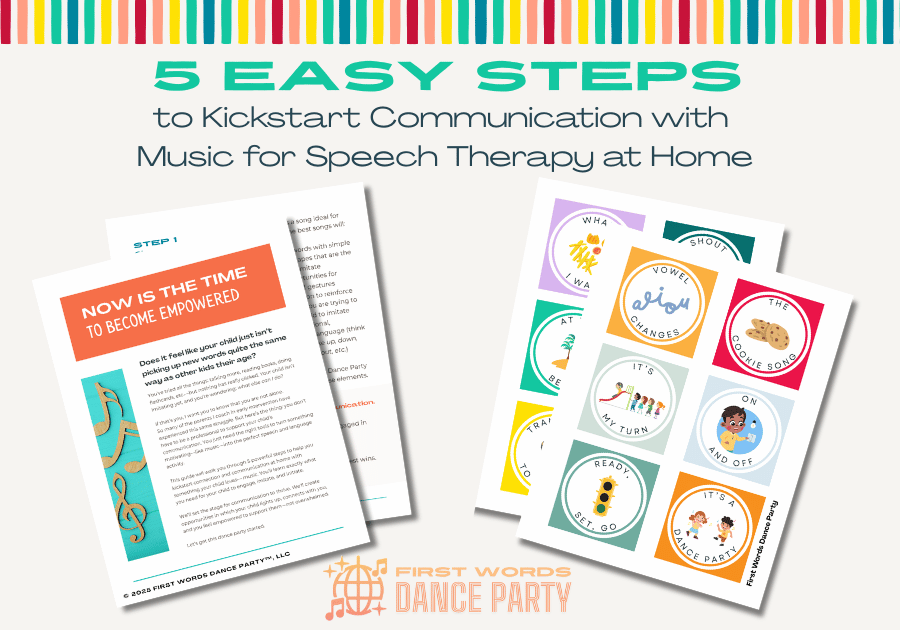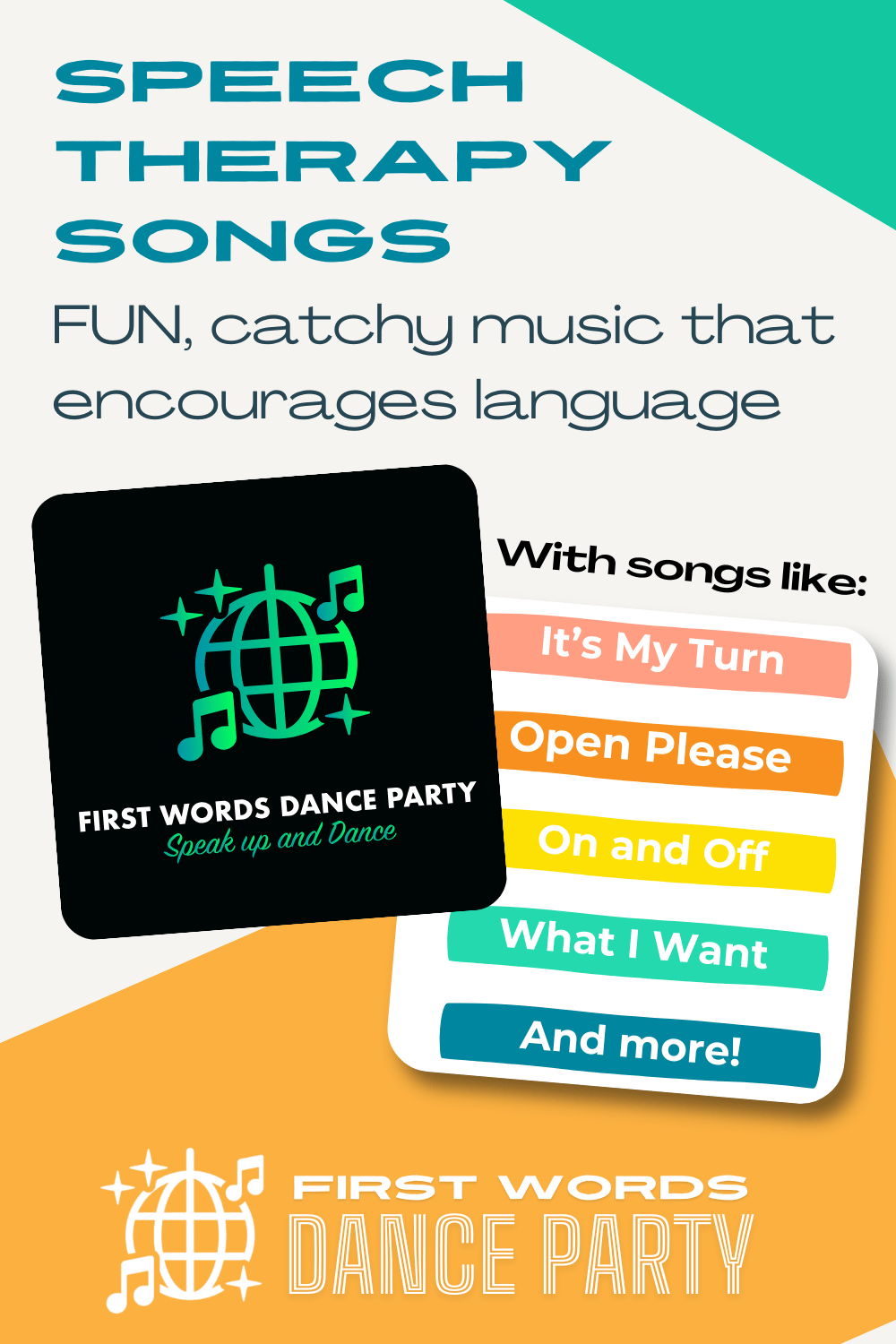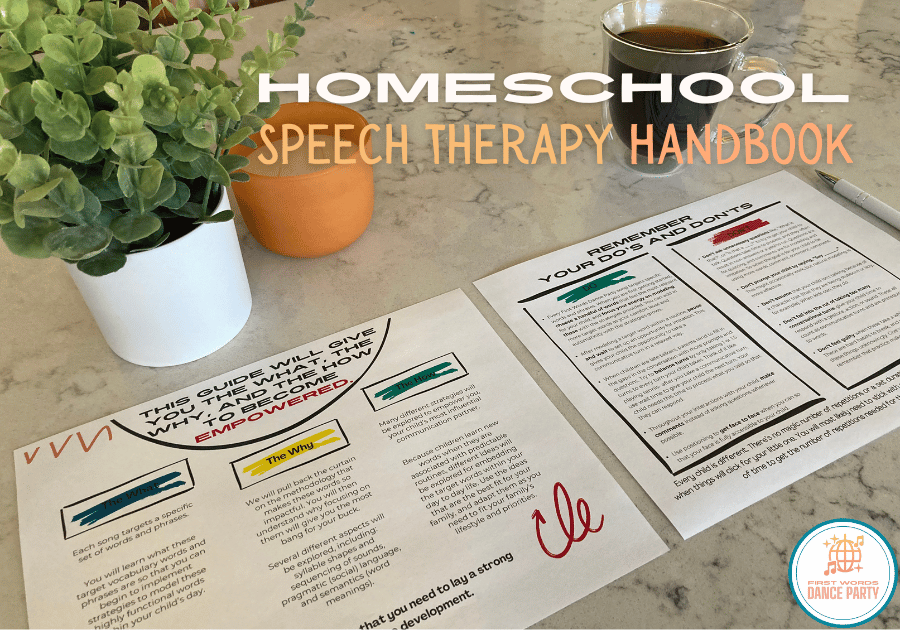Music for Speech Therapy: 5 Easy Ways to Accomplish Speech Success at Home
- 0 comments
When people think about speech therapy, they don’t always think about music—but the truth is, using music for speech therapy is a no-brainer.
If your child has a speech delay or language disorder, you’ve probably tried it all—flashcards, special toys, maybe even a few apps or videos that promise to help your child start talking.
And while some of those tools can be helpful, there’s one strategy that never disappoints—one that has never let me down in over a decade of working with toddlers and preschoolers across the entire ability spectrum.
That strategy is music.
Music is a powerful therapeutic tool—one that supports emotional regulation while opening the door to language in a way that brings joy.
In the fifteen years that I’ve coached parents in early intervention, I’ve worked with kiddos with widely varying levels of speech and language needs. And while no two children have been exactly alike, every single child I’ve met has shared one thing in common- a love of music.
Even when kids don’t have the words yet to sing along or ask for a favorite song, the joy that music brings them is unmistakable.
We can see it in their joyful expressions and in the ways they move their bodies to the rhythm. We see it when they suddenly stop whatever they’re doing and look up when a favorite song begins.
If your child isn’t using many words yet, you may be unsure of what to do and what not to do- and you’re not alone. Many parents I coach in early intervention feel stuck, frustrated, or overwhelmed when their child won’t imitate their words.
That’s why I started creating music for speech therapy that weaves in the strategies we use everyday in early intervention.
You can download a free guide to discover 5 easy, parent-friendly steps to use songs for speech therapy at home to spark connection and communication with your child. As a bonus, you’ll receive song boards with cards for every First Words Dance Party™ song, so your child can make choices and initiate.
Let’s dive in. I’ll walk you through the science, the strategy, and some favorite ways to get started at home.
Music and Language Work Together in the Brain
Both music and language activate overlapping regions in the auditory and motor systems. This means that when children engage with music, they’re also strengthening the same neural pathways used for speech and language.
According to researchers at Harvard Medical School, musical experiences in early childhood are linked to stronger language development and communication skills. Music can improve listening, boost verbal memory, and help young children recognize sound patterns that form the basis of spoken language.
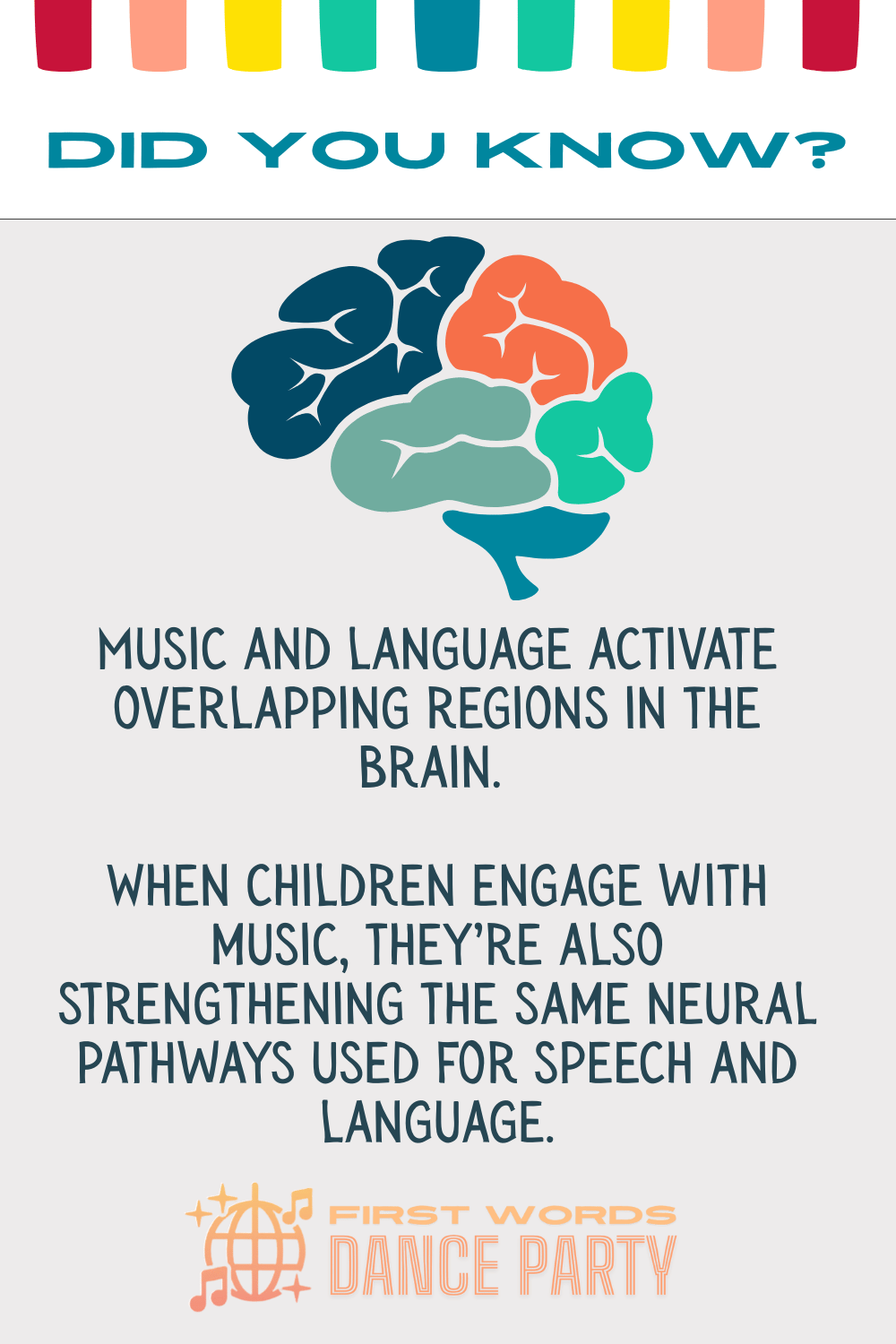
What the Science Says About Language and Music
Let’s nerd out for a second, shall we? 🤓
According to Johns Hopkins Medicine, "Just listening to music activates more brain regions simultaneously than any other human activity”.
The Brazilian Journal of Otorhinolaryngology finds that people with musical training tend to have stronger central auditory processing skills, which helps the brain make sense of sounds. For children, early exposure to music can speed up auditory development and support language learning.
Another NIH study demonstrates that babies experience language like music over their first year—tuning into rhythm, pitch, and melody long before they understand words. This early “musical” listening helps them connect with the world, and even as they grow, they never lose the ability to hear sounds in a creative, imaginative way.
The Journal of Neuroscience finds that music also enhances memory and sequencing, which are essential skills for building sentences and understanding routines.
This NIH study found that music-based interventions may help individuals on the autism spectrum develop expressive language by stimulating and strengthening connections between brain regions involved in speech and motor planning. By tapping into the brain’s natural ability to adapt, these approaches offer a promising way to support communication through engaging, motivating activities.
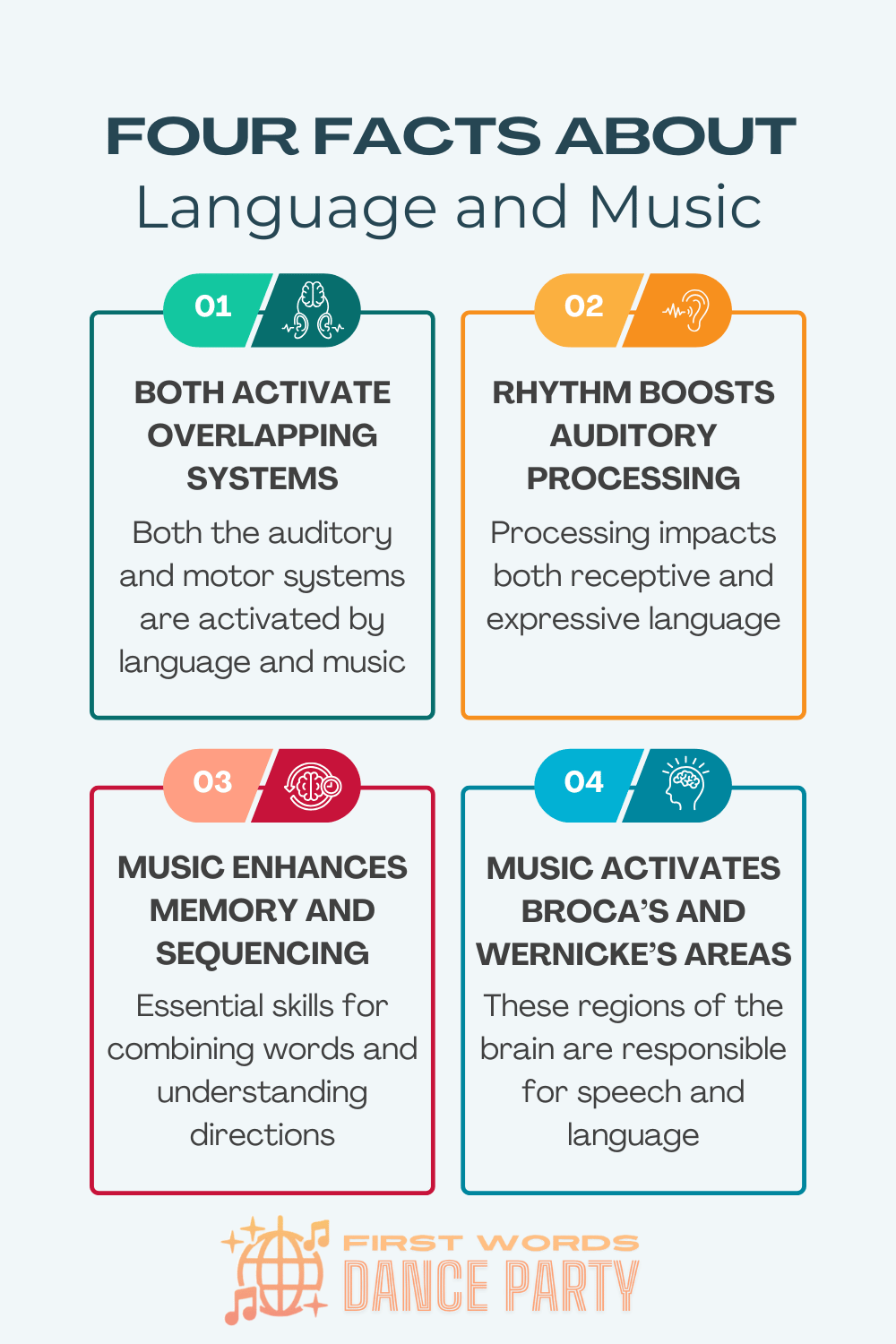
Put simply, music helps to build the very cognitive structures kids need for communication.
Reasons to use music and speech therapy strategies together with your late talker
For children with speech delays or expressive and receptive language disorders, music may offer an easier “way in.” A child might not verbally imitate or respond consistently yet to conversational speech, but a familiar song can spark attention, invite interaction, and even lead to early vocalizations.
Music activates both hemispheres of the brain at once—which supports memory, emotional regulation, and new learning. That’s part of why children often remember song lyrics more easily than spoken language. Engaging with music lights up the brain in a multi-sensory way, making it a uniquely powerful tool for early learning.
When you sing with your child, you're not just having fun. You're supporting language, memory, attention, and connection— the perfect combination for speech therapy success.
It Captures Attention and Builds Engagement
One of the most powerful reasons to use music in speech therapy is to capture a child’s attention. Music has a remarkable ability to do this, especially when other approaches fall flat.
Maybe this sounds familiar: your child is busy playing and isn’t really responding when you call their name or speak to them. But then,when you start singing “Baby Shark”, they suddenly look up and smile as if to say, “You get me, mom”.
That moment of connection is a sign that they are engaged and ready to listen and learn.
In speech therapy, engagement is everything. Engagement is the foundation for imitation. When a child is engaged, their brain is ready to learn—and that’s when speech therapy strategies have the most impact.
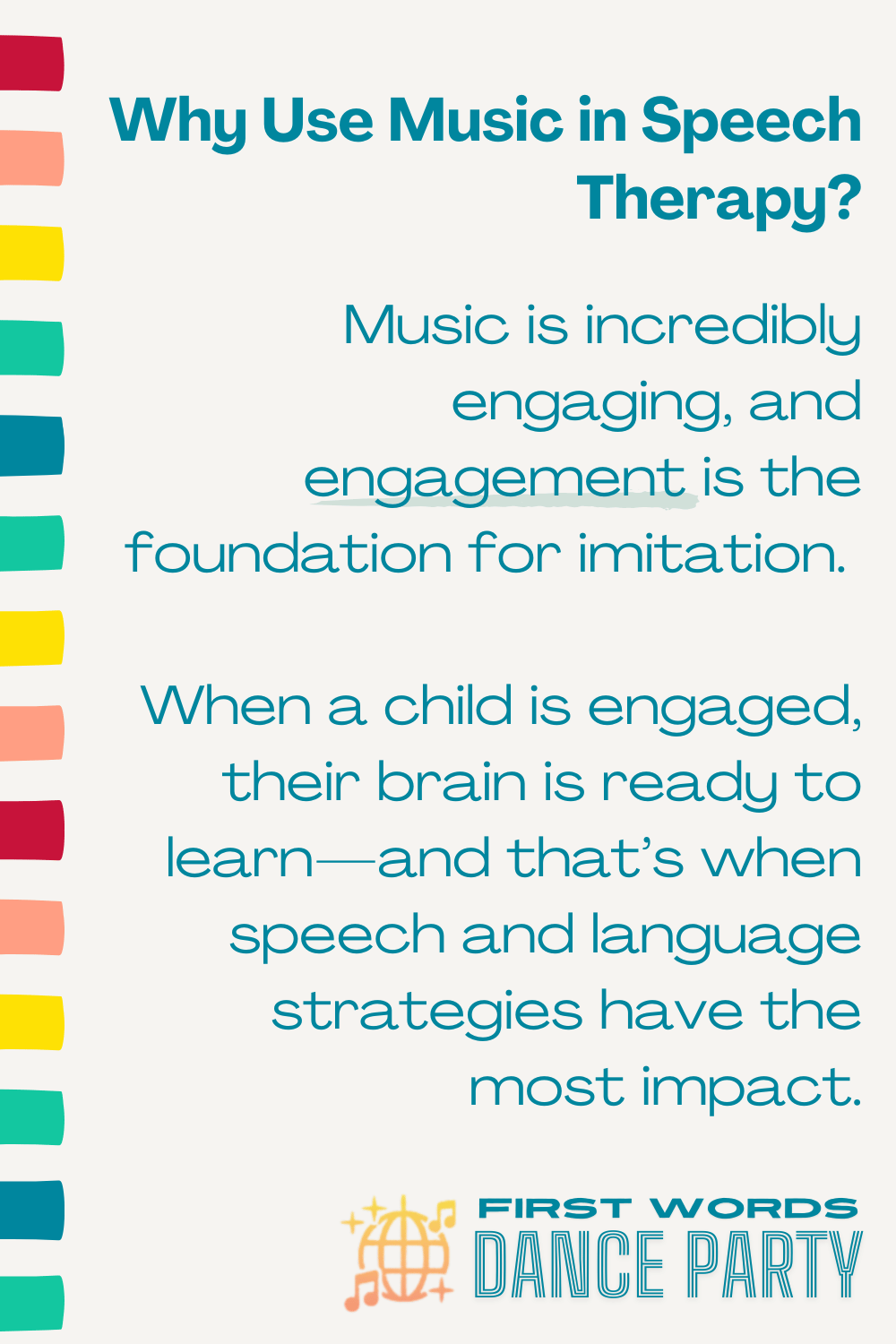
Music invites participation in a way that feels natural and rewarding. The rhythm, melody, and predictability of a song holds a child’s focus longer than spoken language often can.
And because music is so inherently enjoyable, children are more likely to get engaged quickly, and to stay engaged longer than they can for other activities. That makes music a powerful tool for practicing early communication skills like joint attention, taking turns, and imitating.
This is especially true for toddlers and preschoolers with expressive and receptive language disorders. When communication is hard, music can offer a break from frustration. It becomes a space where your child can participate and express themselves—even without using words.
Using music for speech delay intervention also supports emotional regulation
Music isn’t just helpful for language—it supports the whole child. That’s one of the reasons it’s so effective in speech therapy.
Music is multi-sensory. It combines sound, movement, touch, and often visuals. For kids who are struggling to communicate, bringing speech therapy and music together can result in more opportunities to stay engaged, to imitate, and to remember.

Music can calm the nervous system, bring structure and predictability to routines and transitions, and create space for connection between you and your child.
Let’s talk about emotional regulation. Many children with speech delays or language disorders struggle with emotional regulation—and communication breakdowns can sometimes trigger frustration and meltdowns.
Music offers a grounding rhythm that helps organize the body and mind. The predictability of a melody, the rhythm of a beat, even the simple act of swaying together to a familiar tune—all of it can have a regulating effect.
But just as importantly, music gives you a way to connect with your child. When so much of your day feels filled with redirecting, prompting, or trying to interpret your child’s needs, singing together can feel like a relief. It can be a time for you and your child to enjoy something together.
It offers opportunities for repetition and predictability
Music welcomes repetition. Kids love hearing the same songs over and over—and every time they do, they’re reinforcing vocabulary, rhythm, and language structures. Repetition is necessary for learning, and with music, it doesn’t feel like work.
And the predictability of a song can lower anxiety. This is a huge win, because kids have to be regulated in order to access the language center of the brain. When the emotional centers of the brain are lit up, the language center can't fully operate.
This is what makes music so uniquely powerful in speech therapy. They support engagement, emotional regulation, and sensory integration at the same time—setting the stage for language growth.
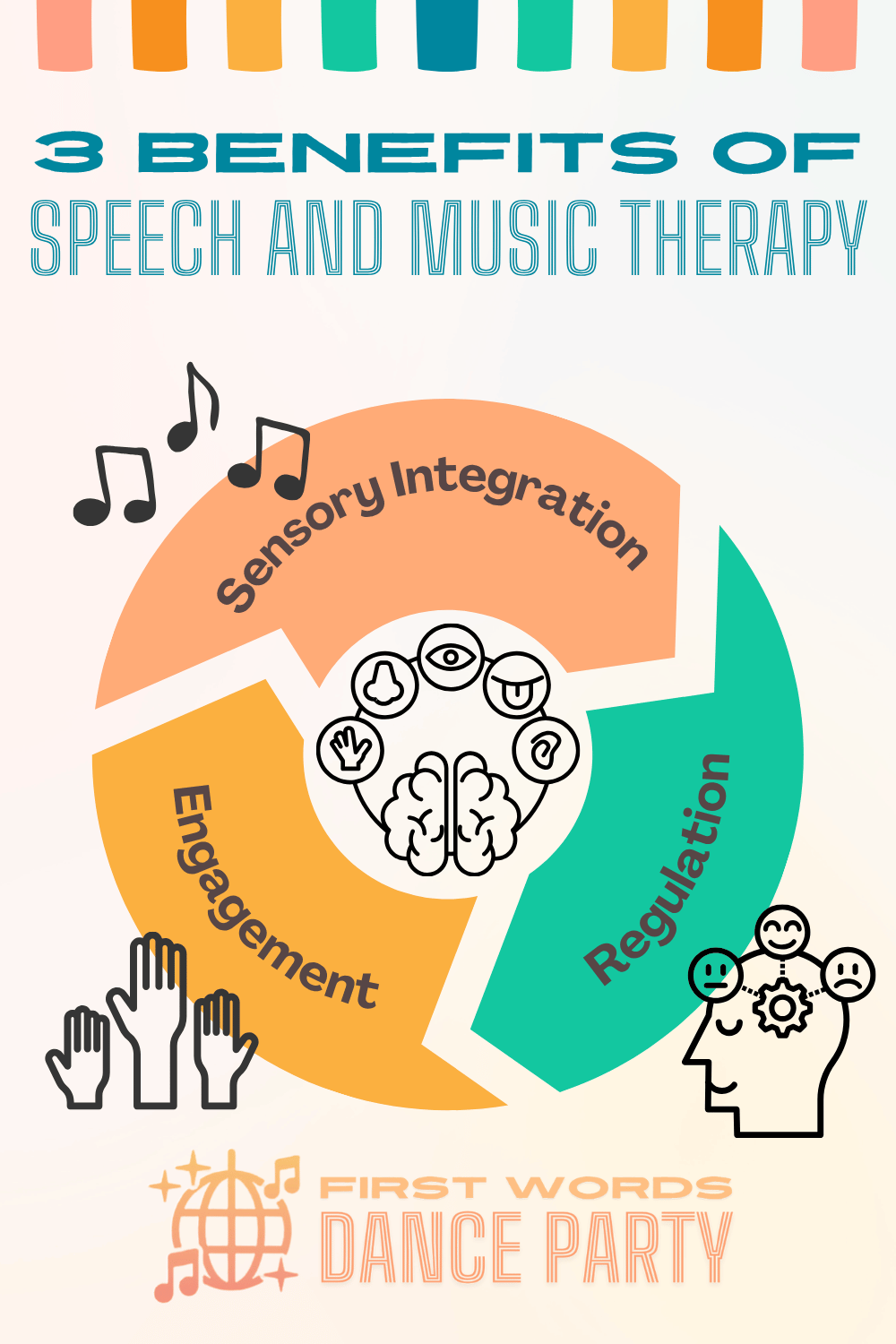
Speech therapy songs support different types of language learners
There are two different language processing styles, and children generally fall into one or the other.
Most children are analytic language learners who process language at the individual word level. These kiddos gradually add single words into their vocabularies and start using two word combinations once they have about fifty words.
Some kiddos are gestalt language processors who start by using larger chunks of language—scripts, echolalia, or full lines from songs and shows—and learn to break those into smaller parts over time.
Both of these are valid language paths. And the great news is that music supports both.
For analytic language learners (children who develop language word-by-word), songs provide predictable exposure to vocabulary and sentence structures. Hearing the same words in rhythmically patterned phrases gives children repeated opportunities to absorb language in context.
And because the lyrics are consistent every time, children can begin to anticipate and eventually say the words along with you.
For gestalt language processors (children who learn language in larger chunks), songs act as meaningful scripts. A line from a song, like “up above the word so high”, might be stored as a whole unit of language.
These kinds of scripts carry emotional weight, and they’re more likely to stick when they come from something that sparks an emotional memory.
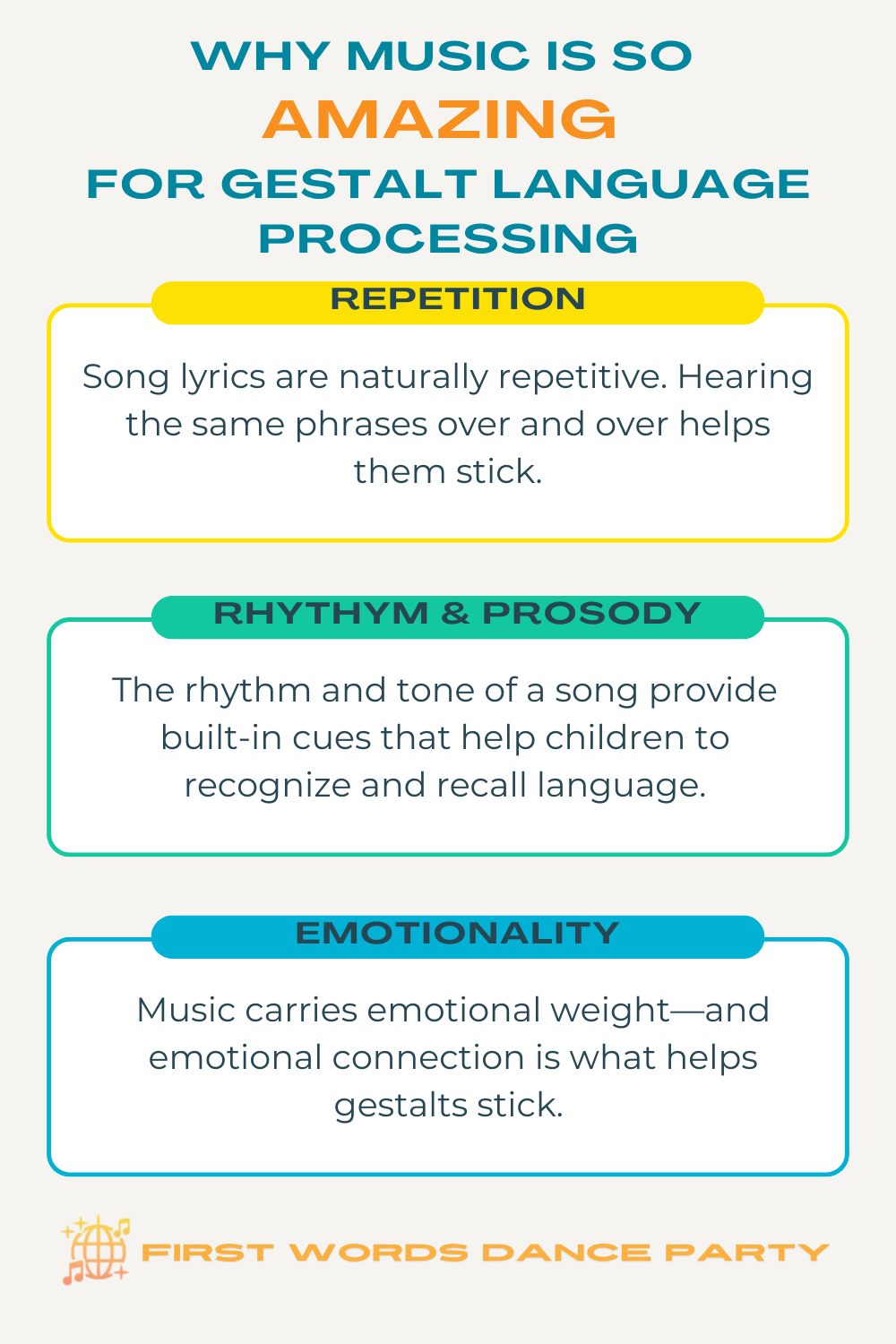
The key is this: songs make language accessible. Whether your child is piecing together phrases one word at a time or starting with full gestalts, music meets them where they are and gives them something to hold onto.
Combining speech therapy and music naturally supports multimodal communication
Another reason music is such a powerful tool in speech therapy is that it naturally encourages multimodal communication—using more than one way to express or understand language.
When you sing with your child, you're not just using your voice. You’re also using facial expressions, gestures, movement, rhythm, and often visuals. A simple song becomes a physical experience: you might clap, pat, use hand motions, or use gestures. Your child might point, smile, move their body, or imitate your actions—even if they’re not speaking yet.
That’s multimodal communication. It’s how children learn language best—through rich, interactive experiences that invite participation and connection.
Music welcomes every child to participate at their individual skill level, regardless of how many words they have. And that kind of inclusivity builds confidence for both kids and parents.
First Words Dance Party: Music for Speech Therapy
There are plenty of children’s songs out there—but they weren’t written with speech therapy in mind. That’s where First Words Dance Party is different.
These original songs for speech therapy were created not only for children, but for adults, too. They offer a refreshing alternative to traditional nursery rhymes—something you’ll actually enjoy singing along with on repeat. And every lyric uses speech therapy strategies.
Here are a few examples:
The Cookie Song: This kid favorite targets the core words yes and no, along with the words eat, want, what, doggie, and of course, cookie! This one is perfect for kids who aren’t yet gesturing or saying yes and no.
Vowel Changes: An irresistibly catchy tune that specifically targets two-syllable words in which the vowel sounds are different (words like mommy, daddy, baby, puppy, etc.). This one is perfect for little ones who say mama and dada, but don’t quite yet say mommy, daddy, or a wide variety of two-syllable words
Ready, Set, Go: This one uses a powerful strategy, called an anticipatory set, to promote engagement. It targets the opposite pair stop and go, along with the words push, pull, bubbles, uh-oh, oh no, more, and I. Check out this core words lyrics video to see how easy it is to model the core words in this song:
You can stream First Words Dance Party on Spotify, YouTube Music, Apple Music, and anywhere else you get your music.
What makes First Words Dance Party’s speech therapy music dynamic
Each song is built around simple, functional language that’s easy to model and use across daily routines. You’ll hear words and phrases like “shoes on,” “my turn”, “help me” and “open please”.
The lyrics were crafted this way so that these functional phrases can be carried over into real day to day routines.
The lyrics also model the simplest and most accessible syllable shapes. In the world of speech and language, syllable shapes are referred to by the order in which the consonants (C) and vowels (V) are sequenced within them.
Every lyric methodically features these early developing syllable shapes. Consonant-vowel words (CV words like go and me), vowel-consonant words (VC words like up, on), consonant-vowel-consonant words (CVC words like push and pull), and reduplicated patterns (ni-night, bye-bye)—make the lyrics perfect for early verbal imitation.
Whether your child has a speech delay or a language disorder, these songs meet them right where they are.
And because they were created to sound fun and catchy to grown-ups, too, parents are more likely to sing them, repeat them, and build them into everyday routines—without dreading another round of The Wheels on the Bus.
These songs weren’t created to replace speech therapy. They were created to amplify it—by helping families bring evidence-based strategies into real life in a way that feels doable, loving, and fun.
Speech therapy songs and resources for practice at home
If you’ve ever felt the weight of trying to support your child’s speech progress at home—wondering “Where do I even start?” or feeling like the things you have tried just haven’t been successful—you’re absolutely not alone. Trying to navigate speech therapy home activities that feel meaningful and manageable (rather than another exhausting to‑do) can leave you drained, second‑guessing, and wishing for something simpler.
That’s where the Homeschool Speech Therapy Handbook comes in. Designed specifically for parents (not trained therapists) who want real‑life tools, this guide breaks down exactly what to do, why it works, and how to bring speech‑therapy practice into everyday moments—snack time, bath time, play time—without turning your home into a clinic.
Framed within a song-by-song breakdown of the Speak up and Dance album, you’ll discover how to apply the strategies within each song to real life for easy speech therapy practice at home. You’ll move from feeling overwhelmed and unsure to feeling confident and connected—watching your child engage, communicate, and grow in ways that feel easy and natural.
5 Ways to use music and speech therapy strategies for quick, easy wins
Once you’ve got your First Words Dance Party songs, it’s time to have some fun. Here are 5 quick, easy ways to get started using speech therapy songs with your child today.
1. Try listening to music for speech in the car
If you’re not feeling very confident about singing with your child, start with listening to songs for speech therapy in the car. This approach works well for kiddos who have very strong preferences toward specific songs and/or are used to watching music videos on YouTube.
When you listen in the car, you and your child can share that experience together without the power struggle of a screen. Since your child will be buckled into their carseat, this also provides the added benefit of your child sharing the same space with you as you learn the lyrics and casually sing along. If your kiddo is a mover and tends to be on-the-go, listening in the car is a perfect starting place.
Starbucks Drive-Thru + Music for Speech Therapy = Parenting Win. It's simple math!
2. Offer choices to encourage language
Pay attention to your child’s cues to see if you can figure out which songs they appear to like most. Their smiles and dancing are clues that something meaningful is happening—and that’s where communication begins.
This is the perfect opportunity to offer choices to your child so that they can make their wants and needs known. You can do this by using the free song boards included with the downloadable 5 Easy Ways to Kickstart Communication with Music for Speech Therapy at Home.
When you cut out the individual symbols, you can hold one in each hand as you ask your child slowly, “Do you want The Cookie Song ... or Ready, Set, Go?”. Your child can look, reach, point, or use sounds or words to make their preference known. This is a huge communication win!
3. Add gestures and actions
Pairing a word with a simple gesture—like pointing to your eyes for “eyes” or tapping your chest for “me”—gives your child a visual way to understand and eventually use the word. Even if they aren’t imitating you, they’re soaking it in. These songs were designed to be paired with sign language, actions, and gestures to boost receptive and expressive language skills.
4. Pause to invite your child to communicate
Leave space within a familiar lyric to give your child time to chime in. This will work well once you are familiar enough with the songs that you feel comfortable singing alone.
Here’s an example. Let’s say you are singing the refrain from It’s a Dance Party and using gestures to dance along and teach body parts. You could use an expectant pause to invite your child to imitate “up” or “get up” like this:
“Now put your hands up, hands up. And put your feet down, feet down. Hop down, hop down….(pause) GET UP, GET UP!”
Even if they don’t respond yet, an expectant pause gives them an opening to try. When you use this strategy repeatedly, kids pick up on the idea that you are looking for them to respond in a fun, low pressure way.
5. Sing during routines
Take the lyrics from the songs and sing a quick line or two during natural parts of the day —like getting dressed, having a snack, or going outside. The lyrics were written for this exact purpose to help your child connect the words in the song to real life. Here are a couple of examples:
Sing, “Open, open, open please” when your child hands you a snack that they need your help to unwrap.
Sing, “My turn, my turn now” to model what your child can say when they want a toy you or a sibling is already using.
When you sprinkle songs into your daily routines, you can help your kiddo to shift their attention. You can take advantage of music’s unique ability to enhance language processing.
Final thoughts on using music in speech therapy
Music is one of the most powerful and enjoyable tools we have to support speech and language development.
Whether your child has a speech delay or is navigating a receptive and expressive language disorder, music offers a fun and effective way to tap into the language center of the brain. Music helps regulate, engage, and connect. It creates space for shared joy and real communication—without pressure.
If you’re ready to take the first step toward connection and communication with your child, download your free 5 Easy Steps to Kickstart Communication with Music for Speech Therapy at Home.
You don’t need to be a professional singer or a speech therapist to leverage the joy of music for major speech and language success. You just need the right songs, some simple strategies, and the willingness to show up with love and consistency.
With those tools, you can put music and speech therapy together for a lasting impact.
Frequently Asked Questions about Music for Speech Therapy
What’s the connection between speech therapy and music?
Language and music go hand-in-hand because they both involve rhythm, repetition, and prosody. Music helps capture a child’s attention, regulate their emotions, and create space for connection—all of which are essential foundations for language development. For these reasons, using music in speech therapy is a no-brainer.
Can music for speech delays really help?
Yes! Music can be incredibly helpful for children with speech delays or expressive and receptive language disorders. Songs provide predictable patterns, repeated vocabulary, and built-in opportunities for imitation. Specialized music for speech delays, like First Words Dance Party, uses these unique assets to target highly functional words and phrases.
What songs work best for music speech therapy success?
The best speech therapy songs are simple, repetitive, and full of functional words that can be generalized to routines outside of music. Bonus points if the lyrics are easy to pair with gestures, signs, or visuals. And of course- they have to be enjoyable! First Words Dance Party’s speech therapy songs were written specifically with these goals in mind.
What’s the difference between speech and music therapy?
Speech and music therapy services are both powerful tools for supporting communication, but they serve different purposes. Speech therapy is typically led by a licensed speech-language pathologist (SLP) and focuses on developing skills like understanding and expressing language, producing speech sounds, and using communication effectively.
Music therapy, on the other hand, is led by a board-certified music therapist and uses music-based experiences—like singing, instrument play, or movement—to support a wide range of goals, including communication, emotional regulation, and motor skills.
What makes First Words Dance Party unique is that it brings together elements from each. We can use music purposefully, with strategies drawn from speech and music therapy, to help young children with speech delays and language disorders engage, connect, and start using language.
Are these songs for speech therapy just for kids who use AAC?
Not at all. These songs support all types of communication. They're designed to be inclusive, whether your child is using AAC, minimally speaking, starting to say their first words, or beginning to imitate more consistently.
What if I’m not a good singer? I feel kind of uncomfortable singing because I’m not very good at it.
This is so relatable. I get it. Singing puts the attention on yourself. But here’s the truth:
Your child doesn’t care if you’re Taylor Swift—they care that you’re meeting them where they are. Singing together (or even just playing the music while you join in with gestures) creates a shared experience that is incredibly beneficial for your child.
You don’t have to be a rock star, a speech-language pathologist, or a teacher to achieve major communication success by using music and speech therapy strategies together- just be you, the amazing parent you already are.
